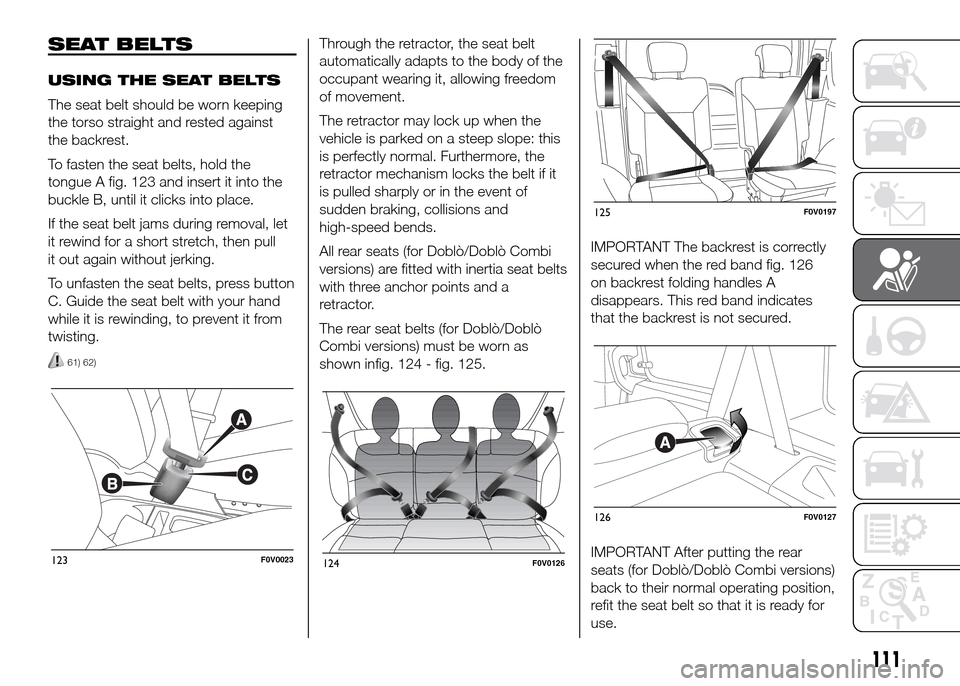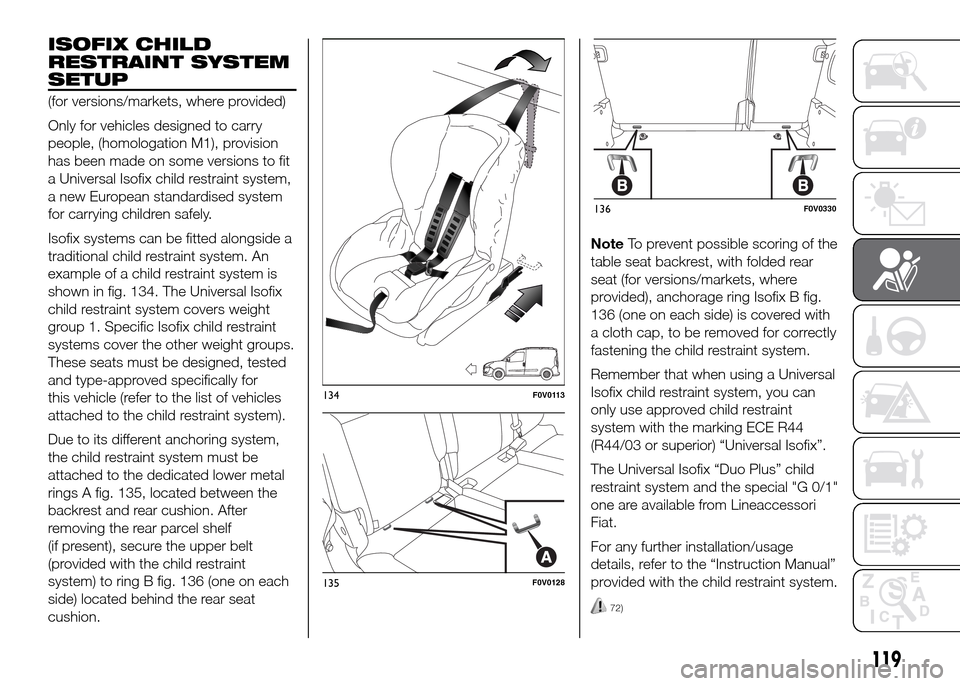Page 65 of 323

WARNING
35) If you are travelling in areas with
few filling stations and you want
to transport fuel in a spare tank,
comply with the law by using only
an approved, suitably secured
tank. However, the risks of fire in
the case of collision increase
anyway.
36) Never exceed the maximum
allowed load in the boot, see
the “Technical specifications”
chapter. Also make sure that the
objects you place in the boot have
been properly secured, to avoid
them from being thrown forward
consequent to sudden braking
and injuring your passengers.37) If you are travelling in areas with
few filling stations and you want
to transport fuel in a spare tank,
comply with the law by using only
an approved, suitably secured
tank. Anyway, by doing so, you
increase the risk of fire in the
event of an accident with your
vehicle.
38) Never exceed the maximum
allowed load in the boot (see
the "Technical specifications"
chapter). Also make sure that the
objects you place in the boot
have been properly secured, to
avoid them from being thrown
forward consequent to sudden
braking and injuring your
passengers.
39) You must not use the folded
rear seat to carry luggage. The
load could be thrown forward into
the backrest of the front seats,
seriously injuring the occupants.
40) Make sure that the objects are
positioned carefully and fixed to
the hooks on the floor to prevent
them being flung forwards in
the event of sharp braking and
causing injury to the passengers.
89F0V0204
400mm400mm
70 kg
90F0V0212
91F0V0114
92F0V0122
61
Page 115 of 323

SEAT BELTS
USING THE SEAT BELTS
The seat belt should be worn keeping
the torso straight and rested against
the backrest.
To fasten the seat belts, hold the
tongue A fig. 123 and insert it into the
buckle B, until it clicks into place.
If the seat belt jams during removal, let
it rewind for a short stretch, then pull
it out again without jerking.
To unfasten the seat belts, press button
C. Guide the seat belt with your hand
while it is rewinding, to prevent it from
twisting.
61) 62)
Through the retractor, the seat belt
automatically adapts to the body of the
occupant wearing it, allowing freedom
of movement.
The retractor may lock up when the
vehicle is parked on a steep slope: this
is perfectly normal. Furthermore, the
retractor mechanism locks the belt if it
is pulled sharply or in the event of
sudden braking, collisions and
high-speed bends.
All rear seats (for Doblò/Doblò Combi
versions) are fitted with inertia seat belts
with three anchor points and a
retractor.
The rear seat belts (for Doblò/Doblò
Combi versions) must be worn as
shown infig. 124 - fig. 125.IMPORTANT The backrest is correctly
secured when the red band fig. 126
on backrest folding handles A
disappears. This red band indicates
that the backrest is not secured.
IMPORTANT After putting the rear
seats (for Doblò/Doblò Combi versions)
back to their normal operating position,
refit the seat belt so that it is ready for
use.
123F0V0023124F0V0126
125F0V0197
126F0V0127
111
Page 123 of 323

ISOFIX CHILD
RESTRAINT SYSTEM
SETUP
(for versions/markets, where provided)
Only for vehicles designed to carry
people, (homologation M1), provision
has been made on some versions to fit
a Universal Isofix child restraint system,
a new European standardised system
for carrying children safely.
Isofix systems can be fitted alongside a
traditional child restraint system. An
example of a child restraint system is
shown in fig. 134. The Universal Isofix
child restraint system covers weight
group 1. Specific Isofix child restraint
systems cover the other weight groups.
These seats must be designed, tested
and type-approved specifically for
this vehicle (refer to the list of vehicles
attached to the child restraint system).
Due to its different anchoring system,
the child restraint system must be
attached to the dedicated lower metal
rings A fig. 135, located between the
backrest and rear cushion. After
removing the rear parcel shelf
(if present), secure the upper belt
(provided with the child restraint
system) to ring B fig. 136 (one on each
side) located behind the rear seat
cushion.NoteTo prevent possible scoring of the
table seat backrest, with folded rear
seat (for versions/markets, where
provided), anchorage ring Isofix B fig.
136 (one on each side) is covered with
a cloth cap, to be removed for correctly
fastening the child restraint system.
Remember that when using a Universal
Isofix child restraint system, you can
only use approved child restraint
system with the marking ECE R44
(R44/03 or superior) “Universal Isofix”.
The Universal Isofix “Duo Plus” child
restraint system and the special "G 0/1"
one are available from Lineaccessori
Fiat.
For any further installation/usage
details, refer to the “Instruction Manual”
provided with the child restraint system.
72)
134F0V0113
135F0V0128
136F0V0330
119